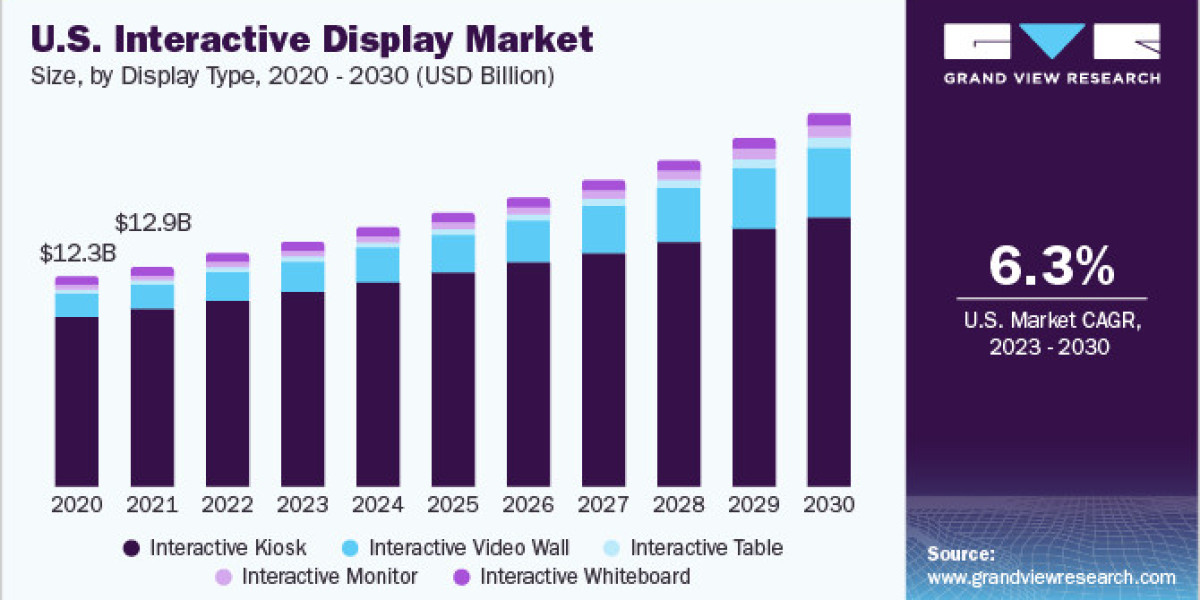The global interactive display market was valued at USD 41.45 billion in 2022 and is projected to grow at a compound annual growth rate (CAGR) of 7.8% from 2023 to 2030. This market includes various products such as interactive kiosks, video walls, tables, monitors, and whiteboards. Interactive displays, also known as touchscreen displays, allow users to give commands through a finger or stylus, replacing traditional peripheral devices like a mouse or keyboard. These displays also project information in the form of text, images, and videos, and they are widely used across industries like retail, healthcare, hospitality, and education. The expected growth is primarily driven by the increasing demand for digital classrooms and the rising adoption of displays like video walls and tables, which are commonly used in public transportation spaces such as airports and railway stations.
Gather more insights about the market drivers, restrains and growth of the Global Interactive Display Market
The growing use of touchscreen tables and video walls in the hospitality and corporate sectors is another significant factor expected to drive market growth during the forecast period. In restaurants, touchscreen tables are used as menu boards that display wait times, prices, and ingredients. In corporate settings, these tables enhance meeting experiences by fostering better engagement between employees, management, and clients.
Digitalization in the education sector, characterized by the use of new technologies such as smartphones, tablets, laptops, touchscreen whiteboards, and tables, has transformed classrooms. These technologies promote greater student engagement, foster creativity, and improve learning retention. Interactive displays also enable better communication, encouraging group learning and participation. They allow teachers to integrate multimedia, such as games, audio clips, and videos, into their lessons, thereby enhancing the learning experience. As students increasingly prefer digital learning, which offers access to relevant digital content, the demand for interactive displays has surged.
Furthermore, internet penetration and changing preferences towards technology have positively influenced the adoption of touch display technologies. The rising emphasis on gamification in education, which incorporates game mechanics into lessons, has also driven market growth. Gamification helps develop cognitive skills and promotes interaction in classrooms by integrating 3D characters and game elements into course material.
Display Type Insights
The market is segmented by display type into interactive kiosks, video walls, tables, monitors, and whiteboards. In 2022, the interactive kiosk segment dominated the market with a share of 73.4%, and it is expected to grow at a CAGR of 7.2% during the forecast period. Interactive kiosks are self-contained devices that enable user interaction through a touchscreen or other input device. They are widely used for tasks like providing information, selling products, processing transactions, and conducting surveys. The growth of this segment is largely due to the increasing demand for self-service solutions in sectors like retail, transportation, and healthcare. Smart vending machines, ATMs, and other touch-enabled self-service devices help businesses deliver efficient service, even during peak hours. These kiosks also allow companies to offer tailored service plans at reduced delivery costs.
The video wall segment is projected to experience the fastest growth, with a CAGR of 11.2% during the forecast period. Interactive video walls consist of multiple screens or projectors tiled together to create a single large display for showing videos, images, and animations. The use of these walls is growing in healthcare facilities, where they provide important information to patients and enhance service delivery. Additionally, rising demand for higher-resolution video walls, driven by pro-technology lifestyles, is increasing product penetration across various industries.
Application Insights
The market is also segmented by application into industries such as retail, hospitality, healthcare, transportation, BFSI (banking, financial services, and insurance), corporate, entertainment, and education. In 2022, the BFSI segment led the market with a 25.8% share and is expected to grow at a CAGR of 8.3% during the forecast period. The rapid adoption of interactive displays in the BFSI sector is driven by their ability to enhance customer engagement, improve user experience, and streamline business operations. With the rise of digital banking and online transactions, consumers increasingly seek convenient and user-friendly ways to interact with financial institutions. Interactive displays offer an engaging interface that simplifies navigation through banking services and products, making the customer experience more personalized.
The retail segment is expected to grow the fastest, with a CAGR of 9.1% over the forecast period. The demand for touch-enabled displays is increasing in the retail sector, driven by the growing use of interactive kiosks and tables. Large retail chains, such as Walmart, have already implemented kiosks to display products along with their prices and specifications, simplifying the in-store experience for customers. Retail spaces, shopping malls, and other commercial areas offer strong growth opportunities for interactive displays. In retail environments, video walls allow customers to check product availability and browse store inventories. Interactive video walls are also enhancing museum experiences by transforming rooms into immersive virtual spaces, improving visitor engagement.
Order a free sample PDF of the Interactive Display Market Intelligence Study, published by Grand View Research.








